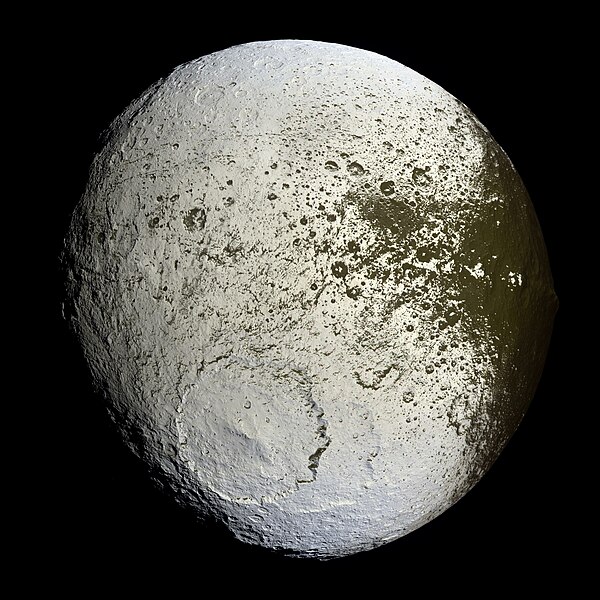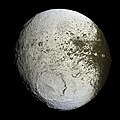File:Iapetus as seen by the Cassini probe - 20071008.jpg
Appearance

Hammi agarsiisa yaalii: pikseelii 600 × 600. Kabiraa furmaatawwan: pikseelii 240 × 240 | pikseelii 480 × 480 | pikseelii 768 × 768 | pikseelii 1,024 × 1,024 | pikseelii 2,048 × 2,048 | pikseelii 4,032 × 4,032.
Faayila abbaa (4,032 × 4,032 pixels, file size: 6.22 MB, MIME type: image/jpeg)
Seenaa faayilaa
Faayilicha sa'aa san akka itti mul'atetti ilaaluuf guyyaa/yeroo cuqaasi.
| Guyyaa/Sa'aa | Qeensa abgudduu | Kallattiiwwan | Fayyadamaa | Yaada | |
|---|---|---|---|---|---|
| amma | 18:07, 12 Muddee 2018 |  | 4,032 × 4,032 (6.22 MB) | Kesäperuna | 100% JPEG quality from full quality TIFF, slightly cropped to be more centered. |
| 09:18, 9 Onkoloolessa 2007 |  | 4,100 × 4,100 (1.56 MB) | Startaq | {{Information |Description = Cassini captures the first high-resolution glimpse of the bright trailing hemisphere of Saturn's moon Iapetus. This false-color mosaic shows the entire hemisphere of Iapetus (1,468 kilometers, or 912 miles across) visible fro |
Fayyadamiinsa faayilaa
Kutaan itti anuu "file"ii kanan walitti qabatta:
Fayyadamiinsa faayila guutu addunyaa
Wikileen biroo kan armaan gadi jiran fayila kana fayyadamu:
- Fayyadamiinsa af.wikipedia.org irratti
- Fayyadamiinsa an.wikipedia.org irratti
- Fayyadamiinsa ar.wikipedia.org irratti
- Fayyadamiinsa ary.wikipedia.org irratti
- Fayyadamiinsa arz.wikipedia.org irratti
- Fayyadamiinsa ast.wikipedia.org irratti
- Fayyadamiinsa az.wikipedia.org irratti
- Fayyadamiinsa ba.wikipedia.org irratti
- Fayyadamiinsa be.wikipedia.org irratti
- Fayyadamiinsa bg.wikipedia.org irratti
- Fayyadamiinsa bn.wikipedia.org irratti
- Fayyadamiinsa bn.wikibooks.org irratti
- Fayyadamiinsa bs.wikipedia.org irratti
- Fayyadamiinsa ca.wikipedia.org irratti
- Fayyadamiinsa ckb.wikipedia.org irratti
- Fayyadamiinsa cs.wikipedia.org irratti
- Fayyadamiinsa cv.wikipedia.org irratti
- Fayyadamiinsa cy.wikipedia.org irratti
- Fayyadamiinsa de.wikipedia.org irratti
Mul'isa fayyadama duniyaalessa edaasaa harshama kanaa.




